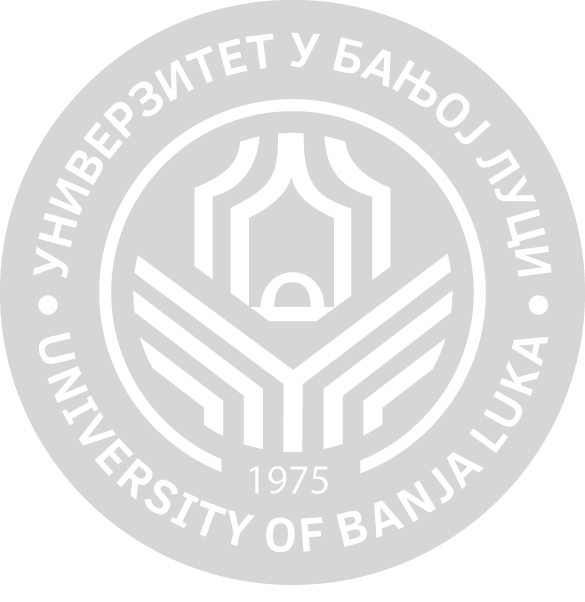 |  |  |  |
Study programme Chemistry, Faculty of Natural Sciences and Mathematics, University of Banja Luka project:
SUCCESUFULY COMPLETED PROJECT: March 31, 2019
„Hybrid Metallic/Carbon Nanomaterials Made from Mining Industry Sludge and Their Applications in Adsorption/Catalysis Treatment of Emerging Pharmaceuticals in Water“
- HOME INSTITUTION: University of Banja Luka, Faculty of Science, Laboratory for Organic Chemistry, Mladena Stojanovića 2, 78000 Banja Luka Tel/Fax: +387/51/319-142, Dr BALABAN Milica (balabanm@pmfbl.org), http://www.pmfbl.org
- HOST INSTITUTION (training for the young researchers Ms Milisavić and Ms Janković): University of Eastern Finland, Department of Environmental and Biological Sciences, YLIOPISTONRANTA 1 E, KUOPIO, 70211 Finland, Tel/fax: +358 503696419; Dr Amit BHATNAGAR (bhatnagar@uef.fi); www.uef.fi
- ADVISORY AND SUPPORT INSTITUTION (additional material analysis, publication preparation): Shinshu University, Center for Energy and Environmental Science, Wakasato 4-17- 1, Nagano, Japan 380-8553 Tel/Fax: +81/26-228-1057, Dr Katsumi KANEKO (kkaneko@shinshu-u.ac.jp) http://www.shinshu-u.ac.jp/
- ADVISORY AND SUPPORT INSTITUTION (measurements of the organic gas concentration in the field, publication preparation): Institute for Protection and Ecology of Republika Srpska, Vidovdanska 43, Banja Luka, Bosnia and Herzegovina, Tel/fax: +387/51-218-318 Dr Predrag ILIĆ ( predrag.ilic@institutzei.net ) http://www.institutzei.net/
ARTICLE PUBLISHED: https://www.sciencedirect.com/science/article/pii/S2214785318330232
Project summary:
Today, principles of green chemistry are being re-examined in accordance with as rapid as ever developments in chemical synthesis area, especially when it comes to the material science and even more so for nano sciences. The onset of the commercialization of nanomaterials in the last 15 years has opened completely new challenges for green chemists. There is a lot of discussion about new risks that nanomaterials pose to the human health and the environment, and this was a subject which was somehow dismissed in early 1980’s when the nanoscience “boom” actually started. Lack of regulations in this area, which would be taking into account all the variations of morphologies, shapes and chemical natures of nanomaterials is also a problem. However, addressing the problematic of the potential negative impact on nature and human health during application and after disposal of nanomaterials is the subject of toxicological and waste management studies. For green chemistry, it is important to start from the beginning and address as “green” as possible routes for production of nanomaterials itself.
In the proposed project, preliminary experiments, which were exploring green synthesis of metallic nanomaterials, have shown great potential of iron mining waste waters as a green source of precursorsfor synthesis of nanoparticles. Also, this precursor was used for preparation of hybrid active carbon/nanoiron material which has proven as an excellent adsorbant for toxic SO2 gas and its catalytic conversion into H2SO4 (useful product). The aim of the present project is to further expand the potential application of this material to the catalytic degradation of pharmaceutical contaminants of water, in particular diclofenac and tetracycline. As shown in the experimental plan below this experiment is completely feasible in the frame of one year.
Long term aim is to show how metallic nanoparticles could and should be produced near to the active mines and/or old mining hotspots. As a result, treated and environmentally safer waste waters would be produced as a part of the iron mine production process, honoring the principles of green chemistry.
Members of the project team:
| Financial coordination and activity supervision: Assist.prof.dr Suzana GOTOVAC ATLAGIĆ email:suzana.gotovac.atlagic@unibl.org |  |
| Project expert: Prof. dr Milica BALABAN |  |
| Dr Maja Stanisavljević, grantee |  |
| Ms Savka Janković, research assistant |  |
| Ms Dragana Milisavić, research assistant |  |
External links:
https://www.phosagro.ru/press/company/item13752.php

